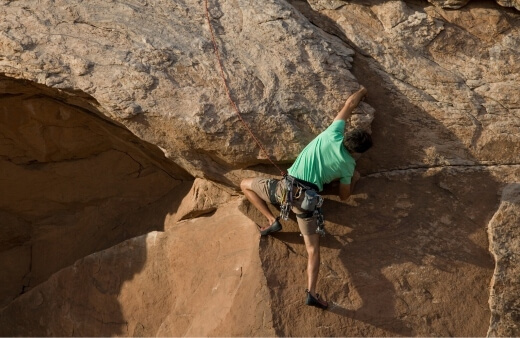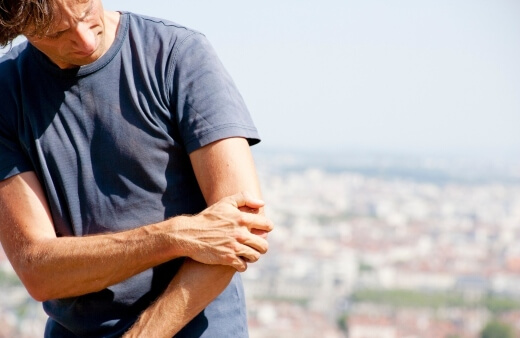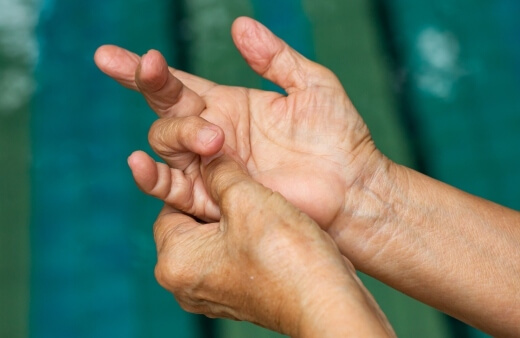Rock climbing is gaining popularity in Australia. It is a physically demanding sport that gives the climber a rush of adrenaline. While there are risks of falling, the most common climbing injuries are due to overuse.

Common Climbing Injuries
1. Rotator Cuff Tears
What are Rotator Cuff Tears?
Rock climbers spend a lot of time pulling up their weight with their arms extended over their heads. This can tear the muscles leading to pain. This type of injury is referred to as a rotator cuff injury.
This Rotator cuff is the group of muscles and tendons that keep your shoulder in the socket
Rotator Cuff Tears Prevention
Stretching and warming up for rock climbing is one way to help prevent rotator cuff tears. It is also important to have strong muscles. There are some strength building exercises that climbers can incorporate to help build shoulder strength. Some of these include internal and external rotations along with lateral shoulder flys.
Treatment for Rotator Cuff Tears
Most rotator cuff tears can be treated with ice, rest and anti-inflammatory drugs. If the injury is serious the shoulder needs to be examined by a specialist. During the exam the Doctor may have an x-ray, ultrasound or MRI performed.
In rare cases, surgery may be necessary. In both cases, the physician may recommend physiotherapy.
2. Tennis Elbow

What is Tennis Elbow?
Tennis elbow, also known as epicondylitis, is a painful condition. It is not always caused by playing tennis. It is the inflammation of the tendons in the forearm. The tendons attach the elbow to the forearm muscle.
Preventing Tennis Elbow
Tennis elbow is often caused by overuse. Climbers need to grip and lift over and over which can lead to tennis elbow. Tennis elbow is not entirely preventable. However, there are some things you can do to help.
These include:
- Warming up the muscles before climbing
- Increase forearm muscle strength
- Use lighter equipment
- Wear a tennis elbow strap
- Take breaks
- Seek the help of an exercise physiologist
Tennis Elbow Treatment
Tennis elbow will usually resolve itself without surgery. Treatment often includes rest, ice, anti-inflammatory medications, massages, steroid injections and bracing. You may also want to see a physiologist.
A physiologist will work with you to get you stronger and get you back to climbing quicker. If the symptoms of tennis elbow do not improve within 6-12 months, you may need surgery.
3. Finger Pulley Tears
What are Finger Pulley Tears?
Climbing finger injuries are very common. Pulleys are ligaments in the fingers that hold the tendons onto the bones. When climbing, they are responsible for carrying an enormous amount of weight.
This weight makes them highly susceptible to tears. Common symptoms of a pulley tear are a popping noise, pain in the palm of hand, a swollen finger and difficulty making a fist.
Finger Pulley Tears Prevention
If you are a climber, it is important to have strong muscles in your hand. There are a few different exercises you can perform to strengthen your muscles and help prevent pulley tears. These can include hangboard finger strengthening, rubber band exercises, and hand exercisers.
Treatment of Finger Pulley Tears
It is very rare surgery is required for a pulley tear. If you experience a pulley injury, apply ice and take anti-inflammatory medicine immediately to lessen the risk of additional damage due to oxygen deprivation. Do not climb until the injury has fully healed.
4. Trigger-Finger Syndrome

What is a Trigger Finger?
Trigger finger is a condition where a cyst forms inside the tendons of the finger. The syndrome is not usually painful. However, the finger can lock, hindering your ability to grip.
Trigger Finger Syndrome Prevention
The best way to prevent trigger-finger is by changing up your training routine. Do not do the same things over and over day after day.
Treatment of Trigger Finger Syndrome
Conservative treatment of the trigger finger often includes a splint, rest and stretching exercises. In severe cases that do not heal on their own, your doctor may recommend steroid injections or percutaneous release. If these do not help, surgery may be required.
5. Hand Tendonitis
What is Tendonitis?
Tendonitis is the inflation of a tendon. Tendonitis can happen anywhere in the body. Climbers often experience hand tendonitis and tendonitis in the wrist. It is also common in the shoulders, forearms and elbows.
Prevention
Tendonitis is a chronic condition that often worsens over time. If you are experiencing symptoms, it is important that you take a break from climbing. The key to prevent tendonitis is by practicing extensor and flexor exercises.
Treatment
Treatment of tendonitis usually involves ice, anti-inflammatory medication, a brace and physiotherapy. If the tendon is torn, your doctor may recommend surgery.
Here are the 4 stages of a climbing specific dynamic warm-up taught by Professional climber Jonathan Siegrist
SSEP Can Help Prevent Future Common Climbing Injuries
If you are new to rock climbing or a seasoned pro, you are vulnerable to injury. A lot of climbers that get injured do not seek help. This is because they do not want to stop climbing. Continuing to climb with an injury can be dangerous.
Learn more about rock climbing and injury prevention on The Climbing Doctor website. One of the best ways to prevent rock climbing injuries is to get in shape and strengthen your muscles. Talk to one of the Exercise Physiologists at SSEP for an opinion and recovery plan.
With their help you may be able to continue climbing whilst recovering from the injury. And when you strengthen your muscles, you will also be helping to prevent future common climbing injuries.
